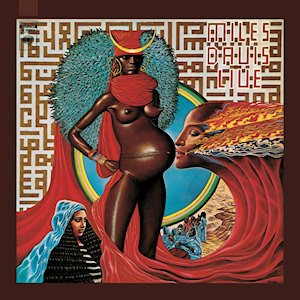Bob Palmer of Rolling Stone felt that Miles Davis’ “Little Church”, “Nem Um Talvez”, and “Selim” are “what used to be called ‘ballads’.
A number of famous jazz musicians feature on the album Live-Evil, including Keith Jarrett and Jack DeJohnette. One of the key musicians on the album, John McLaughlin, was not a regular member of Miles Davis’s band during the time of recording. McLaughlin joined the band for one of the four nights at the Cellar Door, rather like a session player; this is not the case for other Davis albums that he worked on.
Davis had originally intended the album to be a spiritual successor to Bitches Brew, but this idea was abandoned when it became obvious that Live-Evil was something completely different.
From the Live-Evil album, which features Miles Davis: Trumpet, Steve Grossman: Soprano Sax, Chick Corea: Electric Piano, Herbie Hancock: Electric Piano, Keith Jarrett: Organ, John McLaughlin: Guitar, Dave Holland: Electric Bass/Acoustic Bass, Jack Dejohnette: Drums, Airto Moreira: Percussion, Hermeto Pascoal: Drums/Whistling/Voice/Electric Piano. Little Church was composed by Hermeto Pascoal. On this track it’s only Miles on trumpet, Hermeto whistling, Herbie Hancock on organ, and Dave Holland on bass.
Each of these tracks is under four minutes, and they are all things of great beauty”. Black World ’s Red Scott stated All the tracks fuse into a perfect complement of musicians passing moods to each other. In a 1981 review, Robert Christgau said that, apart from the meandering Inamorata, the long pieces are usually fascinating and often exciting, including Funky Tonk, which he called Davis’ most compelling rhythmic exploration to date. He added that the four short pieces are more like impressionistic experiments, and that Selim and Nem Um Talvez appropriately hark back to the late ’50s.
In a retrospective review, Down Beat magazine said that Live-Evil isn’t pyrotechnic techno-dweeb fusion, but an outstandingly creative electric collage. In his 1997 review for JazzTimes, Tom Terrell hailed the album as a seamless mixture of studio and live, and Miles’ true electric rite of passage. Allmusic editor Thom Jurek called its tracks fine and deeply lyrically grooved-out and described the album as the sound of transition and complexity, and somehow it still grooves wonderfully, finding the live material to be wonderfully immediate and fiery. Edwin C. Faust of Stylus Magazine dubbed Live-Evil one of the funkiest albums ever recorded and commented that its somber short pieces are haunting examples of musical purity—Miles enriching our ears with evocative melodies (his work on Sketches of Spain comes to mind) while the bass creeps cautiously, an organ hums tensly, and human whistles/vocals float about forebodingly like wistful phantoms. Pitchfork Media’s Ryan Schreiber called the album easily the most accessible of Miles Davis’ late-’70s electric releases and described its music as at once both sexually steamy and unsettling, writing that The 15+ minute live jams […] run the gamut from barroom brawl action-funk to sensual bedroom jazz magic, creating two hours of charged eccentricity you’ll never forget. Erik Davis, writing in Spin magazine, called Live-Evil kinetic and said that it splices together live chunks and cool studio vignettes, and features the Hindu heavy-metal fretwork of John McLaughlin.
